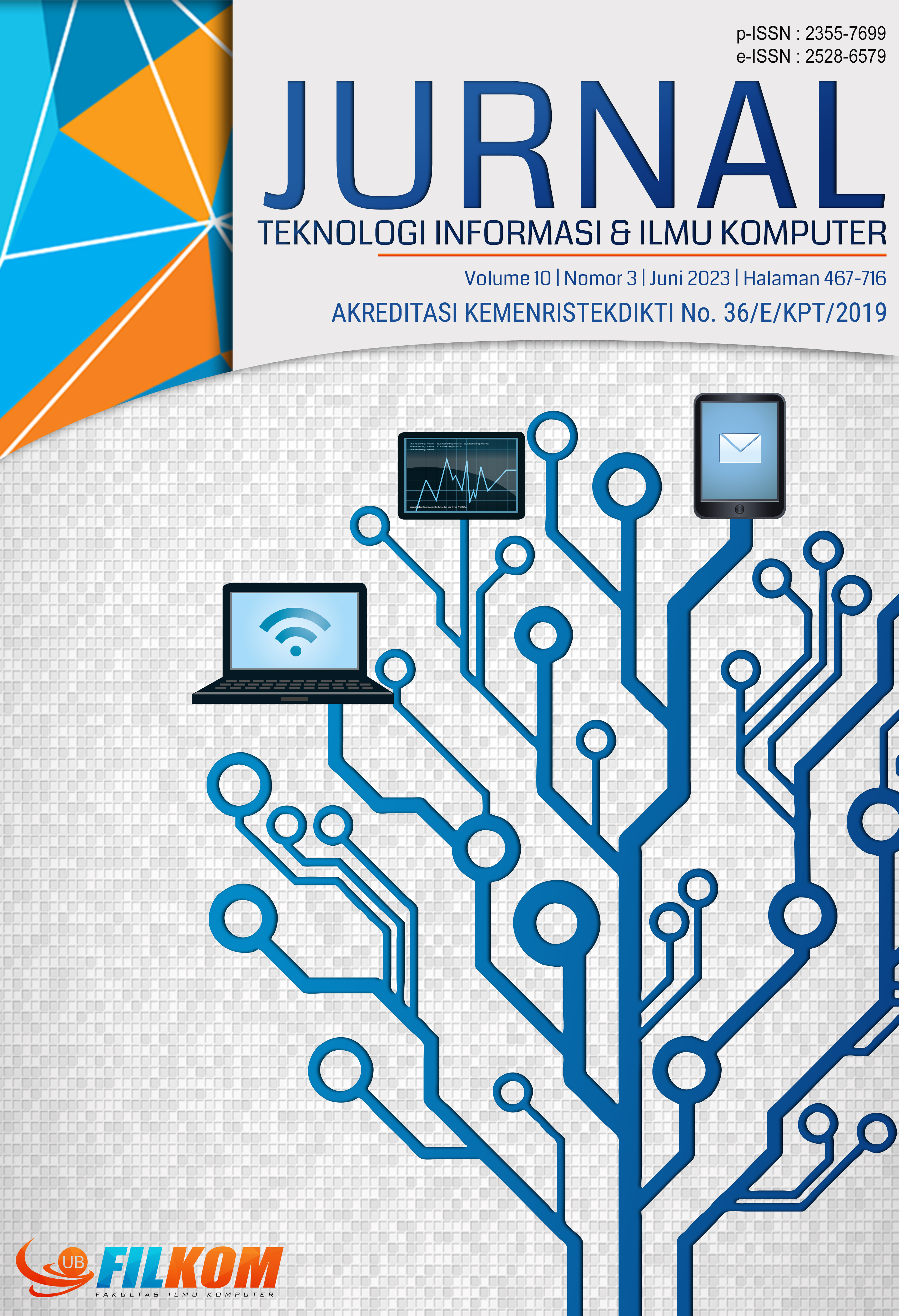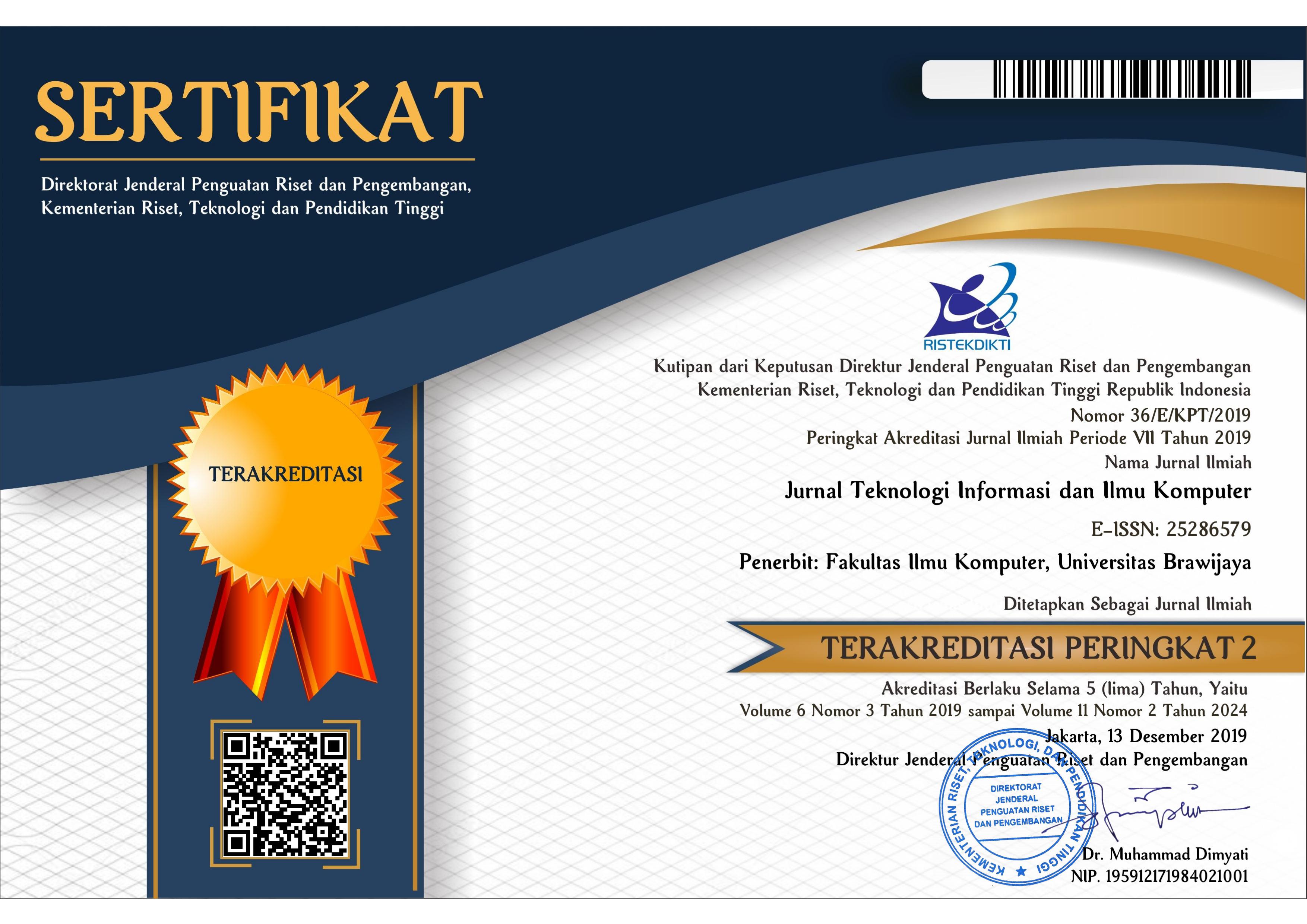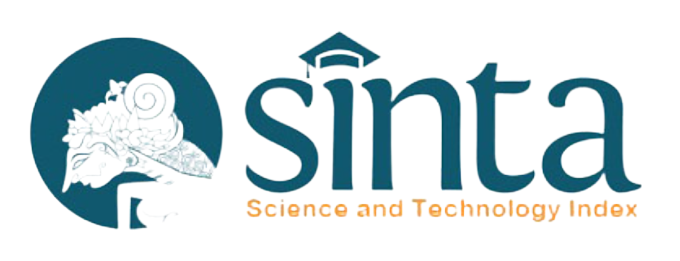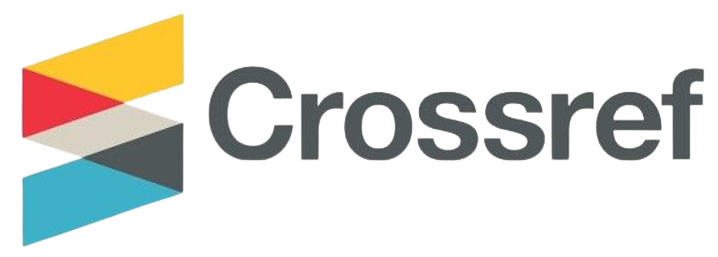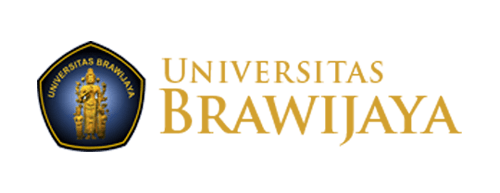Pemanfaatan Aplikasi Pengiriman Makanan Pasca Penurunan Level Pembatasan Kegiatan Masyarakat Akibat Covid-19 Di Indonesia
DOI:
https://doi.org/10.25126/jtiik.2023106859Abstrak
Penggunaan aplikasi pengiriman makanan meningkat sangat cepat, terlebih saat terjadinya Pandemi COVID-19, dimana pergerakan orang dibatasi, membuat setiap orang berupaya menggunakan aplikasi pengiriman makanan atau Food Delivery Application (FDA) dalam memenuhi kebutuhan pangan. Penurunan jumlah kasus COVID-19 menyebabkan pemerintah Indonesia menurunkan level Pemberlakuan Pembatasan Kegiatan Masyarakat (PPKM) sehingga masyarakat dapat beraktivitas sosial kembali. Tujuan penelitian ini adalah untuk menilai instrumen yang memengaruhi Continuance Intention FDA pasca penurunan level PPKM COVID-19 menjadi level 1 di Indonesia. Sebanyak 166 responden telah dikumpulkan. Kuesioner terdari dari 17 pertanyaan demografi dan 38 pertanyaan indikator. Skala Likert dengan lima tingkat penilaian digunakan untuk mengevaluasi pertanyaan indikator. Model yang digunakan adalah Unified Theory of Acceptance and Use of Technology 2 (UTAUT2). Data dianalisis dengan menggunakan Structural Equation Modeling (SEM) berbasis Partial Least Square (PLS), meliputi analisis faktor, analisis jalur, dan regresi. Penelitian menunjukkan Performance Expectancy, Social Influence, Habit, dan Rasa Solidaritas berdampak signifikan pada Continuance Intention FDA. Effort Expectancy, Facilitating Condition, Hedonic Motivation, Price Value, dan Risk Perception menunjukkan pengaruh yang tidak signifikan terhadap Continuance Intention. Pengembang FDA dapat menggunakan data ini untuk meningkatkan layanan mereka dan menambah pemahaman tentang FDA, loyalitas pengguna, peluang bisnis dan strategi pemasaran. Restoran dapat menggunakan kajian ini untuk melihat pergeseran pola pembelian makanan.
Abstract
The use of food delivery applications is increasing very quickly, especially during the COVID-19 Pandemic, when people's movements were restricted, making everyone try to use Food Delivery Applications (FDA) to meet their meal needs. The decrease in the number of COVID-19 cases has caused the Indonesian government to lower the level of Enforcement of Restrictions on Community Activities (PPKM) so that people can return to common social activities. The purpose of this study was to assess the instruments that influence the FDA's Continuance Intention after the reduction in the level of PPKM COVID-19 to level 1 in Indonesia. A total of 166 respondents have been collected. The questionnaire consists of 17 demographic questions and 38 indicator questions. A Likert scale with five rating levels was used to evaluate the indicator questions. The model used is the Unified Theory of Acceptance and Use of Technology 2 (UTAUT2). Data were analyzed using Partial Least Square (PLS) based Structural Equation Modeling (SEM), including factor analysis, path analysis, and regression. Research shows Performance Expectancy, Social Influence, Habit, and Sense of Solidarity have a significant impact on FDA Continuance Intention. Effort Expectancy, Facilitating Condition, Hedonic Motivation, Price Value, and Risk Perception show no significant effect on Continuance Intention. FDA developers can use this data to improve their services and increase their understanding of the FDA, user loyalty, and identify marketing opportunities and strategies. Restaurants can use this assessment to see shifts in food purchasing patterns.
Downloads
Referensi
ALALWAN, A.A., 2020. Mobile food ordering apps: An empirical study of the factors affecting customer e-satisfaction and continued intention to reuse. International Journal of Information Management, 50, pp.28–44.
BROWN, S.A. dan VENKATESH, V., 2005. Model of Adoption of Technology in Households: A Baseline Model Test and Extension Incorporating Household Life Cycle. MIS Quarterly, [online] 29(3), pp.399–426.
BYRD, K., HER, E.S., FAN, A., ALMANZA, B., LIU, Y. dan LEITCH, S., 2021. Restaurants and COVID-19: What are consumers’ risk perceptions about restaurant food and its packaging during the pandemic? International Journal of Hospitality Management, 94.
CHO, M., BONN, M.A. dan LI, J. (JUSTIN), 2019. Differences in perceptions about food delivery apps between single-person and multi-person households. International Journal of Hospitality Management, 77, pp.108–116.
CHOPDAR, P.K. dan SIVAKUMAR, V.J., 2019. Understanding continuance usage of mobile shopping applications in India: the role of espoused cultural values and perceived risk. Behaviour and Information Technology, 38(1), pp.42–64.
DOWLING, G.R. dan STAELIN, R., 1994. A Model of Perceived Risk and Intended Risk-handling Activity. Journal of Consumer Research, [online] 21.
FORSYTHE, S.M. dan SHI, B., 2003. Consumer patronage and risk perceptions in Internet shopping. Journal of Business Research, 56(11), pp.867–875.
GUO, Y., 2014. Moderating effects of gender in the acceptance of mobile SNS-Based on UTAUT model. In: Proceedings - 2014 International Conference on Management of e-Commerce and e-Government, ICMeCG 2014. Institute of Electrical and Electronics Engineers Inc. pp.163–167.
HAKIM, M.P., ZANETTA, L.D.A. dan DA CUNHA, D.T., 2021. Should I stay, or should I go? Consumers’ perceived risk and intention to visit restaurants during the COVID-19 pandemic in Brazil. Food Research International, 141.
HONG, J.C., LIN, P.H. dan HSIEH, P.C., 2017. The effect of consumer innovativeness on perceived value and continuance intention to use smartwatch. Computers in Human Behavior, 67, pp.264–272.
Instruksi Menteri Dalam Negeri Nomor 42 Tahun 2022 tentang Pemberlakuan Pembatasan Kegiatan Masyarakat Pada Kondisi Corona Virus Disease 2019 di Wilayah Jawa dan Bali.
Instruksi Menteri Dalam Negeri Nomor 43 Tahun 2022 tentang Pemberlakuan Pembatasan Kegiatan Masyarakat Level 1 Serta Mengoptimalkan Posko Penanganan Corona Virus Disease 2019 di Tingkat Desa dan Kelurahan Untuk Pengendalian Penyebaran Corona Virus Disease 2019 di Wilayah Sumatera, Nusa Tenggara, Kalimantan, Sulawesi, Maluku, dan Papua.
JADIL, Y., RANA, N.P. dan DWIVEDI, Y.K., 2021. A meta-analysis of the UTAUT model in the mobile banking literature: The moderating role of sample size and culture. Journal of Business Research, 132, pp.354–372.
JAPLANI, A. dan SEJA AL GANI, G., 2022. Dampak Pengumuman COVID-19 Sebagai Bencana Nasional Indonesia Terhadap Reaksi Pasar Modal pada Sub Sektor Pariwisata, Restoran dan Hotel (Studi Peristiwa Pada IHSG Yang Terdaftar di Bursa Efek Indonesia). Kalianda Halok Gagas, [online] 4(2).
KA, I., LAI, W., SHI, G., LAI, I.K.W. dan SHI, G., 2015. The impact of privacy concerns on the intention for continued use of an integrated mobile instant messaging and social network platform. Int. J. Mobile Communications, 13(6), pp.641–669.
LIMAYEM, M., HIRT, S.G. dan CHEUNG, C.M.K., 2007. How Habit Limits the Predictive Power of Intention: The Case of Information Systems. MIS Quarterly, [online] 31(4), pp.705–737.
MARINKOVIĆ, V., ĐORĐEVIĆ, A. dan KALINIĆ, Z., 2020. The moderating effects of gender on customer satisfaction and continuance intention in mobile commerce: a UTAUT-based perspective. Technology Analysis and Strategic Management, 32(3), pp.306–318.
MAULIDYA IZZATI, B., 2020. Analysis of Customer Behaviour in Mobile Food Ordering Application Using UTAUT Model (Case Study: GoFood Application). International Journal Of Innovation In Enterprise System, [online] 4(1).
MISHRA, C. dan RATH, N., 2020. Social solidarity during a pandemic: Through and beyond Durkheimian Lens. Social Sciences & Humanities Open, 2(1), p.100079.
MONICA, C. dan BRILIANA, V., 2019. Faktor-Faktor Yang Mempengaruhi Continuance Intention Pengguna Go-Food Di Jakarta. Jurnal Wira Ekonomi Mikroskil, 9(2).
MUN, Y.P., KHALID, H. dan NADARAJAH, D., 2017. Millennials’ Perception on Mobile Payment Services in Malaysia. In: Procedia Computer Science. Elsevier B.V. pp.397–404.
NASCIMENTO, B., OLIVEIRA, T. dan TAM, C., 2018. Wearable technology: What explains continuance intention in smartwatches? Journal of Retailing and Consumer Services, 43, pp.157–169.
NISA, K. dan KHOIRUNNISA, T., 2022. Pemilihan Layanan Pesan Antar Makanan Online Terbaik Menggunakan Metode Weighted Product. Jurnal Ilmiah Media Sisfo, [online] 16(2), pp.145–154.
OULASVIRTA, A., RATTENBURY, T., MA, L. dan RAITA, E., 2012. Habits make smartphone use more pervasive. Personal and Ubiquitous Computing, 16(1), pp.105–114.
OWUSU KWATENG, K., OSEI ATIEMO, K.A. dan APPIAH, C., 2019. Acceptance and use of mobile banking: an application of UTAUT2. Journal of Enterprise Information Management, 32(1), pp.118–151.
PAMUNGKAS, Z.Y. dan SUDIARNO, A., 2022. Implementasi Model UTAUT (Unified Theory Of Acceptance And Use Of Technology) Untuk Menganalisis Faktor-Faktor Yang Mempengaruhi Penggunaan Aplikasi Brimo. Jurnal Teknologi Informasi dan Ilmu Komputer (JTIIK), [online] 9(3), pp.569–578.
PIARNA, R. AND FATHUROHMAN, F., 2020. Adopsi E-Commerce Oleh Konsumen Milenial Pada Produk UMKM Di Kota Subang Menggunakan Model UTAUT In Consumer Contex. Jurnal Teknologi Informasi dan Ilmu Komputer (JTIIK), 7(5), pp.1021–1028.
PUTRI, N.S., GUNAWAN, J. dan WIBAWA, B.M., 2021. Identifikasi Faktor yang Mempengaruhi Niat Keberlanjutan Penggunaan Layanan Online Food Delivery di Masa Pandemi COVID-19. Jurnal Sains dan Seni ITS, 10.
RAY, A., DHIR, A., BALA, P.K. dan KAUR, P., 2019. Why do people use food delivery apps (FDA)? A uses and gratification theory perspective. Journal of Retailing and Consumer Services, 51, pp.221–230.
ROH, M. dan PARK, K., 2019. Adoption of O2O food delivery services in South Korea: The moderating role of moral obligation in meal preparation. International Journal of Information Management, 47, pp.262–273.
SABRI ALRAWI, M.A., SAMY, G.N., YUSOFF, R.C.M., SHANMUGAM, B., LAKSHMIGANTHAN, R., MAAROP, N. dan KAMARUDDIN, N., 2020.
Examining factors that effect on the acceptance of mobile commerce in Malaysia based on revised UTAUT. Indonesian Journal of Electrical Engineering and Computer Science, 20(3), pp.1173–1184.
SHAO, Z., ZHANG, L., LI, X. dan GUO, Y., 2019. Antecedents of trust and continuance intention in mobile payment platforms: The moderating effect of gender. Electronic Commerce Research and Applications, 33.
SJAHROEDDIN, F., 2018. The Role of E-S-Qual and Food Quality on Customer Satisfaction in Online Food Delivery Service. In: Prosiding Industrial Research Workshop and National Seminar. pp.551–558.
Statista, 2022. Online Food Delivery - Worldwide. [online] Available at:
SUDARYONO, RAHWANTO, E. dan KOMALA, R., 2020. E-Commerce Dorong Perekonomian Indonesia, Selama Pandemi COVID 19 Sebagai Entrepreneur Modern Dan Pengaruhnya Terhadap Bisnis Offline. Jurnal Manajemen Dan Bisnis (JUMANIS) Prodi Kewirausahaan, 2(2).
SUNGBOONLUE, P., THANAKAEW, S., RANGSEEPANYA, K., TANGPATONG, T. dan SIRIBORVORNRATANAKUL, T., 2022. A study of redesigning food delivery application in Thailand. Telkomnika (Telecommunication Computing Electronics and Control), 20(5), pp.1073–1082.
SWINYARD, W.R. dan SMITH, S.M., 2003. Why People (Don’t) Shop Online: A Lifestyle Study of the Internet Consumer. Psychology and Marketing, 20(7), pp.567–597.
TAM, C., SANTOS, D. dan OLIVEIRA, T., 2020. Exploring the influential factors of continuance intention to use mobile Apps: Extending the expectation confirmation model. Information Systems Frontiers, 22(1), pp.243–257.
TANDON, A., KAUR, P., BHATT, Y., MÄNTYMÄKI, M. dan DHIR, A., 2021. Why do people purchase from food delivery apps? A consumer value perspective. Journal of Retailing and Consumer Services, 63.
Tenggara Strategic, 2022. Riset Tenggara Strategics: Pasca-Pandemi, Permintaan Layanan Pesan AntarMakanan Tetap Tinggi. [online] Available at: <https://tenggara.id/research/ Online-Food-Delivery-OFD-Consumption-Behavior-and-Perception-Survey-in-Indonesia.>.
VENKATESH, V., SMITH, R.H., MORRIS, M.G., DAVIS, G.B., DAVIS, F.D. dan WALTON, S.M., 2003. Quarterly User Acceptance Of Information Technology: Toward A Unified View. MIS quarterly, 27(3), pp.425–478.
VENKATESH, V., WALTON, S.M. dan THONG, J.Y.L., 2012. Quarterly Consumer Acceptance and Use of Information Technology: Extending the Unified Theory of Acceptance and Use of Technology. MIS Quarterly, [online] 36(1), pp.157–178.
WANG, Y.S., TSENG, T.H., WANG, W.T., SHIH, Y.W. dan CHAN, P.Y., 2019. Developing and validating a mobile catering app success model. International Journal of Hospitality Management, 77, pp.19–30.
XU, C., PEAK, D. dan PRYBUTOK, V., 2015. A customer value, satisfaction, and loyalty perspective of mobile application recommendations. Decision Support Systems, 79, pp.171–183.
YADAV, R., SHARMA, S.K. dan TARHINI, A., 2016. A multi-analytical approach to understand and predict the mobile commerce adoption. Journal of Enterprise Information Management, 29(2), pp.222–237.
YAN, M., FILIERI, R. dan GORTON, M., 2021. Continuance intention of online technologies: A systematic literature review. International Journal of Information Management,
YEO, V.C.S., GOH, S.K. dan REZAEI, S., 2017. Consumer experiences, attitude and behavioral intention toward online food delivery (OFD) services. Journal of Retailing and Consumer Services, 35, pp.150–162.
YUAN, S., LIU, Y., YAO, R. dan LIU, J., 2016. An investigation of users’ continuance intention towards mobile banking in China. Information Development, 32(1), pp.20–34.
ZANETTA, L.D.A., HAKIM, M.P., GASTALDI, G.B., SEABRA, L.M.A.J., ROLIM, P.M., NASCIMENTO, L.G.P., MEDEIROS, C.O. dan DA CUNHA, D.T., 2021. The use of food delivery apps during the COVID-19 pandemic in Brazil: The role of solidarity, perceived risk, and regional aspects. Food Research International, 149.
ZHAO, Y. dan BACAO, F., 2020. What factors determining customer continuingly using food delivery apps during 2019 novel coronavirus pandemic period? International Journal of Hospitality Management, 91.
ZHOU, T., 2011. Examining the critical success factors of mobile website adoption. Online Information Review, 35(4), pp.636–652.
Unduhan
Diterbitkan
Terbitan
Bagian
Lisensi

Artikel ini berlisensi Creative Common Attribution-ShareAlike 4.0 International (CC BY-SA 4.0)
Penulis yang menerbitkan di jurnal ini menyetujui ketentuan berikut:
- Penulis menyimpan hak cipta dan memberikan jurnal hak penerbitan pertama naskah secara simultan dengan lisensi di bawah Creative Common Attribution-ShareAlike 4.0 International (CC BY-SA 4.0) yang mengizinkan orang lain untuk berbagi pekerjaan dengan sebuah pernyataan kepenulisan pekerjaan dan penerbitan awal di jurnal ini.
- Penulis bisa memasukkan ke dalam penyusunan kontraktual tambahan terpisah untuk distribusi non ekslusif versi kaya terbitan jurnal (contoh: mempostingnya ke repositori institusional atau menerbitkannya dalam sebuah buku), dengan pengakuan penerbitan awalnya di jurnal ini.
- Penulis diizinkan dan didorong untuk mem-posting karya mereka online (contoh: di repositori institusional atau di website mereka) sebelum dan selama proses penyerahan, karena dapat mengarahkan ke pertukaran produktif, seperti halnya sitiran yang lebih awal dan lebih hebat dari karya yang diterbitkan. (Lihat Efek Akses Terbuka).

